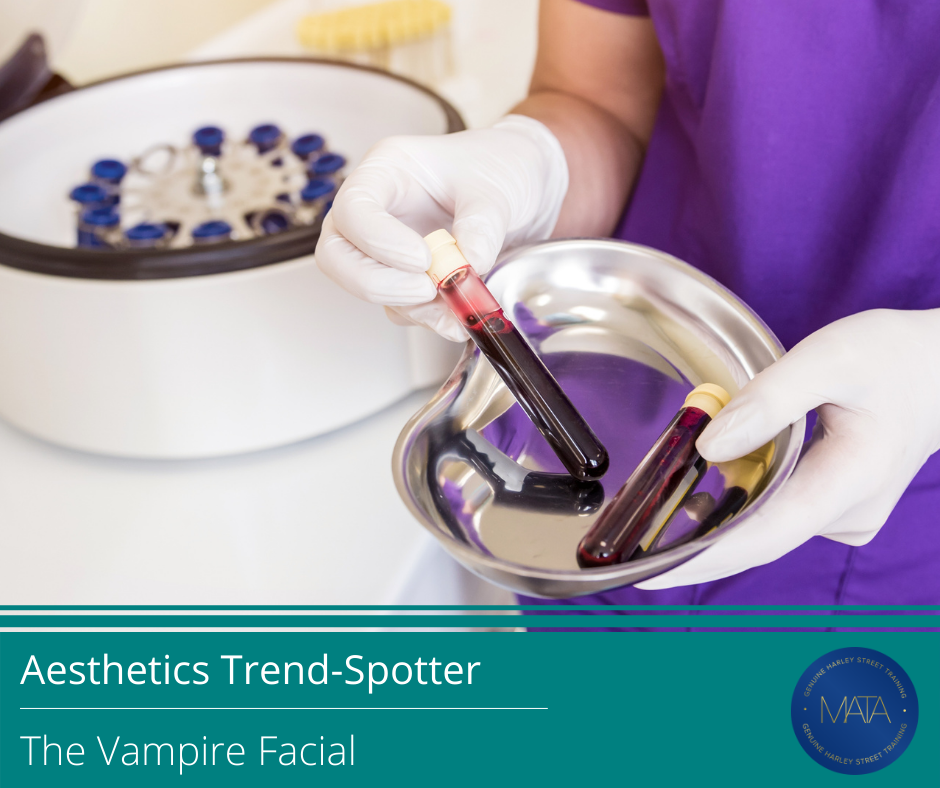
The Vampire Facial has grown hugely in popularity since Kim Kardashian’s 2013 grisly photo of herself midway through treatment, with over 232 thousand mentions on Instagram and 37.6 million views on TikTok. The treatment combines microneedling with platelet-rich plasma derived from the clients’ own blood; and it’s been claimed that the procedure can give a youthful appearance that rivals that created by injectables like Botox or filler.
How Is The Treatment Performed?
Step One – The Blood Draw: The blood is usually drawn from the arm, then placed into a centrifuge and spun to separate the red blood cells and the platelet-poor plasma from the Platelet-Rich Plasma.
Step Two – Facial Cleansing and Numbing: The clients’ face is cleansed and a numbing cream is applied to lessen the pain from the microneedling process.
Step Three – Preparation: The Platelet-Rich Plasma is drawn into a needleless syringe for ease of applying small quantities to the clients’ skin during the facial, and the microneedling device is prepared for use.
Step Four – The Facial: The Platelet-Rich Plasma is smoothed onto sections of the face, followed by the microneedling device. The microneedles push the plasma deep into the epidermis, alongside creating tiny controlled injuries to the epidermis that trigger skin healing and stimulates collagen production.
Downtime From the Vampire Facial
Although the Vampire Facial is ‘non-invasive’, this isn’t necessarily a treatment that clients can fit into their lunch break. It can cause swelling and redness for up to twelve hours following the procedure due to the microneedling process, so clients may prefer to make this an after-work treat.
Results From the Treatment
There isn’t a massive body of research on Vampire Facials. Still, practitioners and clients have reported that after a course of three treatments; the appearance of fine lines, acne scarring and skin roughness are much improved. The results from a course of Vampire Facials should last a client up to 12 months.
Risks of the Vampire Facial
Microneedling alone presents some risk to clients. Bacterial infections can occur if the skin or the machine is not cleansed properly. Clients with darker skin tones are also at risk of Post-Inflammatory Hyperpigmentation (PIH), which leaves darker patches of skin in the treated areas.
When blood is added to the microneedling procedure; other, scarier risks come into play. Two clients at a New Mexico salon in the USA contracted HIV after having Vampire Facials, potentially as a result of cross-contamination. Although this may be an isolated case, it is still something that clients should be aware of before undergoing the treatment.
At MATA, we see non-ablative laser treatment as a safe alternative to the Vampire Facial, improving the appearance of fine lines, scarring and skin texture without breaking the skin or requiring blood handling. To register your interest in our newly restructured Laser and Light qualifications, please complete this webform.
Is the Vampire Facial Here to Stay?
Although the Vampire Facial may have become popular due to a celebrity endorsement, almost ten years on it is still a favourite; available in clinics across the UK and the world. As such, it would seem like the procedure is here to stay. As always, we recommend that clients are made fully aware of the risks and rewards of the treatment. In the case of this particular treatment, we’d also recommend that the procedure takes place in a suitable setting and is carried out by a practitioner with experience in the safe handling of blood products.
Should Dermal Filler be Reclassified as Prescription-Only?

Despite the overwhelming rise in popularity of aesthetic injectables, legislation and regulation of the aesthetics industry has not kept pace. This has led to botched dermal filler treatments going viral on social media and to a growing demand from practitioners and the media for greater government oversight of aesthetic injectables practice. In 2019, an All-Party Parliamentary Group (APPG) on Beauty, Aesthetics and Wellbeing was formed and in July 2021 they published their concluding report. This featured a number of recommendations for legislative action and regulatory oversight, including a call to reclassify dermal filler as a prescription-only medication.
Current Dermal Filler Classification
At the moment, Botulinum Neurotoxin is a prescription-only medication, only available from a trained prescriber after a face-to-face consultation with clients to ensure treatment suitability. In contrast, Dermal Fillers are currently classed as a medical device and are freely available for purchase and use by non-medics, with no need for a prescriber to assess clients beforehand.
This lack of medical oversight is a point of concern not only the APPG, but for voluntary bodies within the aesthetics industry including the Joint Council for Cosmetic Practitioners and the British Association of Beauty Therapy & Cosmetology; who have highlighted that “risks of fillers are significant and arguably even greater than those posed by botulinum”.
These risks have been on full display across the media over recent years. Leah Morton, a 26 year old woman from Liverpool, was left at risk of losing her nose after a practitioner caused and then failed to recognise a vascular occlusion during a non-surgical rhinoplasty. Dr Tijion Esho, an experienced aesthetic practitioner and medical professional, shared a clip that showed him treating lip cysts caused by superficial filler placement. Meiska Mamajeski, a 53 year old woman from Leeds was blinded in one eye when her practitioner injected directly into her eye rather than the skin around the eye in 2015.
Proposed Changes
Dermal fillers must be performed under the oversight of a prescriber who has gained the accredited qualifications to prescribe, supervise and provide remedial medicines if necessary.
All-Party Parliamentary Group on Beauty, Aesthetics and Wellbeing
The APPG has recommended that dermal filler be reclassified from Medical Device to a Prescription Only Medication, with the view that this would “remove a significant danger to the general public.” It would make it necessary for all dermal filler providers to ensure that their clients are seen and assessed by a medical prescriber before treatment, helping to ensure that clients are suitable for treatment and that medication such as hyaluronidase can be quickly accessed should the procedure go wrong. This would allow for rapid treatment of vascular occlusions, should the practitioner have the skill to recognise and treat this complication.
MATA’s Opinion
MATA was established with the aim of standardising training in aesthetic injectables within the UK Aesthetics Industry, and as such we welcome greater legislation and regulation. Making dermal fillers prescription-only would be a positive step in the direction of establishing a properly monitored aesthetics industry.
Still, we must highlight that medical and aesthetic professionals have been seeking greater oversight of aesthetic injectables for years. Sir Bruce Keogh noted in his 2013 report that “dermal fillers are a crisis waiting to happen” and suggested that they be made prescription-only; yet almost a decade later, fillers are still freely available and the aesthetic industry is still under-regulated.
It remains to be seen whether the UK Government will work with the MHRA and Manufacturers to reclassify dermal fillers as prescription only. For now, we will continue to train our delegates to a high standard in both the theory and practice of aesthetic injectables through our Level 7 Diploma in Facial Aesthetics, ensuring that they enter practice with the skills they need to recognise and manage complications. We are also committed to supporting the activity of voluntary bodies in the aesthetics industry in their work to regulate and monitor our industry.
MATA’s Response to BBC3’s “Under the Skin: The Botched Beauty Business”.

BBC 3’s recent documentary, “Under the Skin: The Botched Beauty Business” has highlighted the dangers of the unregulated aesthetics industry. Over 30 minutes, the host meets clients who have suffered poor treatment by poorly trained practitioners, and investigates Training Academies which provide inadequate tuition in aesthetic procedures.
At MATA, we are all too aware of these circumstances. We were founded with the goal of improving standards in the aesthetics industry, and originated the Level 7 Post Graduate Diploma in Facial Aesthetics. This is regulated by OFQUAL, accredited by the JCCP and provides the highest industry standard in aesthetic injectable education.
Benefits of MATA’s Level 7 Diploma
Our Level 7 Diploma takes nine months to complete and is only open to medical professionals, making it a far cry from the one-day courses or even virtual courses which have sprung up across the UK. Through extensive e-learning and written assessments alongside a minimum of six practical training days, we ensure that our delegates enter the aesthetic industry with the education and practical training you need to provide long-lasting, safe aesthetic treatments that are centred around the needs of the patient.
We provide 150 hours of online learning, designed to deepen and develop your understanding of the theory behind aesthetics practice. This will be cemented by written assessments that ensure you have full knowledge of risks in aesthetics practice, the literature and research within aesthetics, and that you are able to take a client from consultation to treatment, and to aftercare and follow-up.
Our practical training days are overseen by an expert practitioner with a minimum of three years experience in the aesthetics industry, in addition to their studies and experience as a medical professional. Furthermore, our training days are conducted in groups of no more than six, to ensure that you have the support you need as you carry out treatments.
In addition to online and practical learning, as a MATA delegate you will have access to an exclusive online community which will allow you to share best practice, receive the latest industry news, and to network with your fellow delegates.
If you have taken a one-day course and feel that there are gaps in your practice or understanding of aesthetic injectables, contact us today to discuss beginning your Level 7 Training Journey with MATA.

